Diterpene glycosides and phenolic compounds from the fruits of Xanthium strumarium
Seven compounds including two diterpene glucosides atractyloside (1), carboxyatractyloside (2), and five phenolic
compounds as 5-O-caffeoylquinic acid (3), 1,5-di-O-caffeoylquinic acid (4), 2,3-dihydroxy-1-(4(hydroxy-3-
methoxyphenyl)-propan-1-one (5), (erythro)-1,2-bis(4-hydroxy-3-methoxyphenyl)-1,3-propandiol (6), and phydroxybenzaldehyde (7) were isolated from the fruits of Xanthium strumarium. Their chemical structures were
determined using ESI-MS, 1D NMR, and 2D NMR spectra as well as by comparison of the spectral data with those
reported in the literature. Compounds 4 and 5 were reported from Xanthium genus for the first time. To our best
knowledge, all these compounds were firstly reported from X. strumarium growing in Vietnam
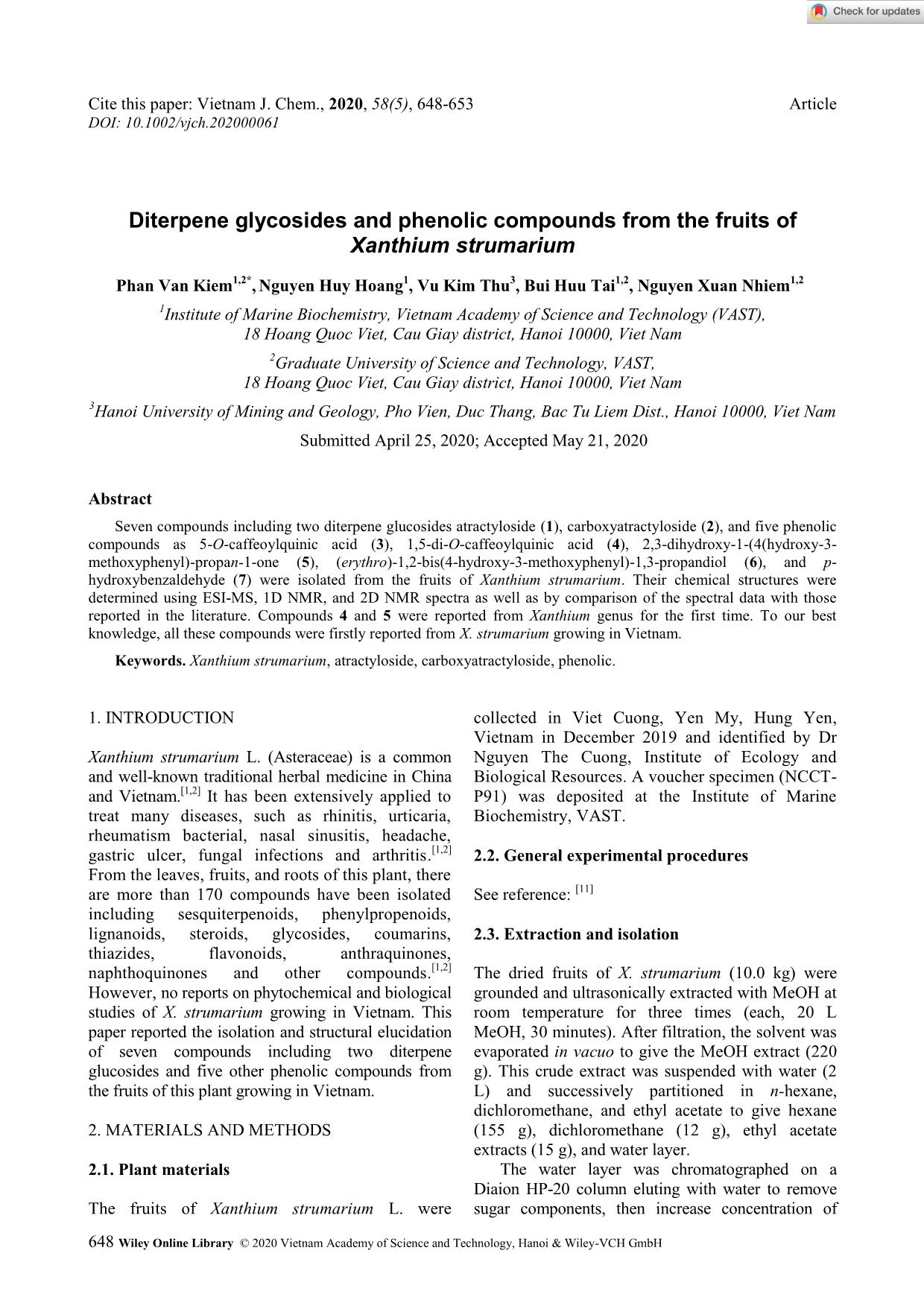
Trang 1
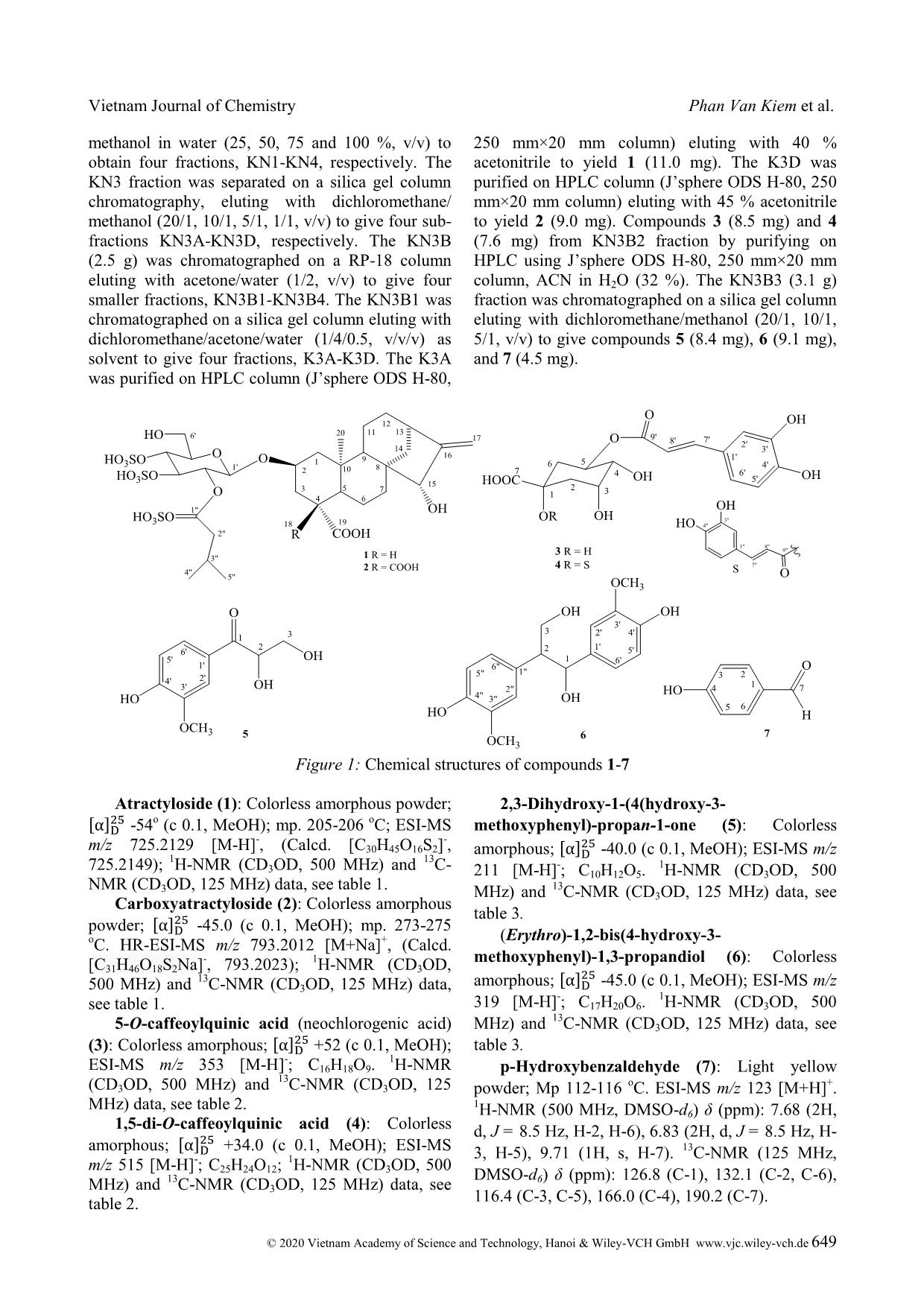
Trang 2
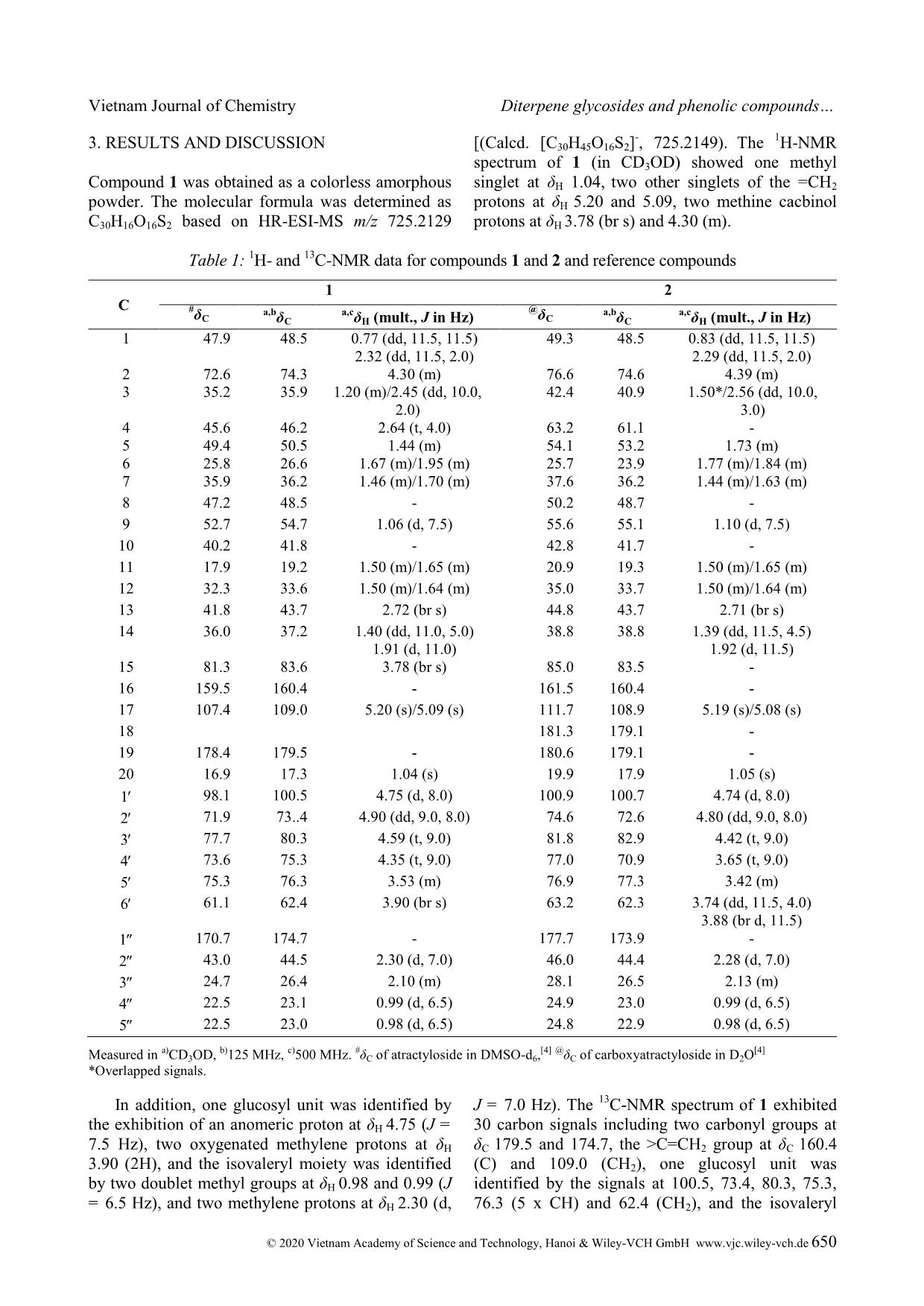
Trang 3
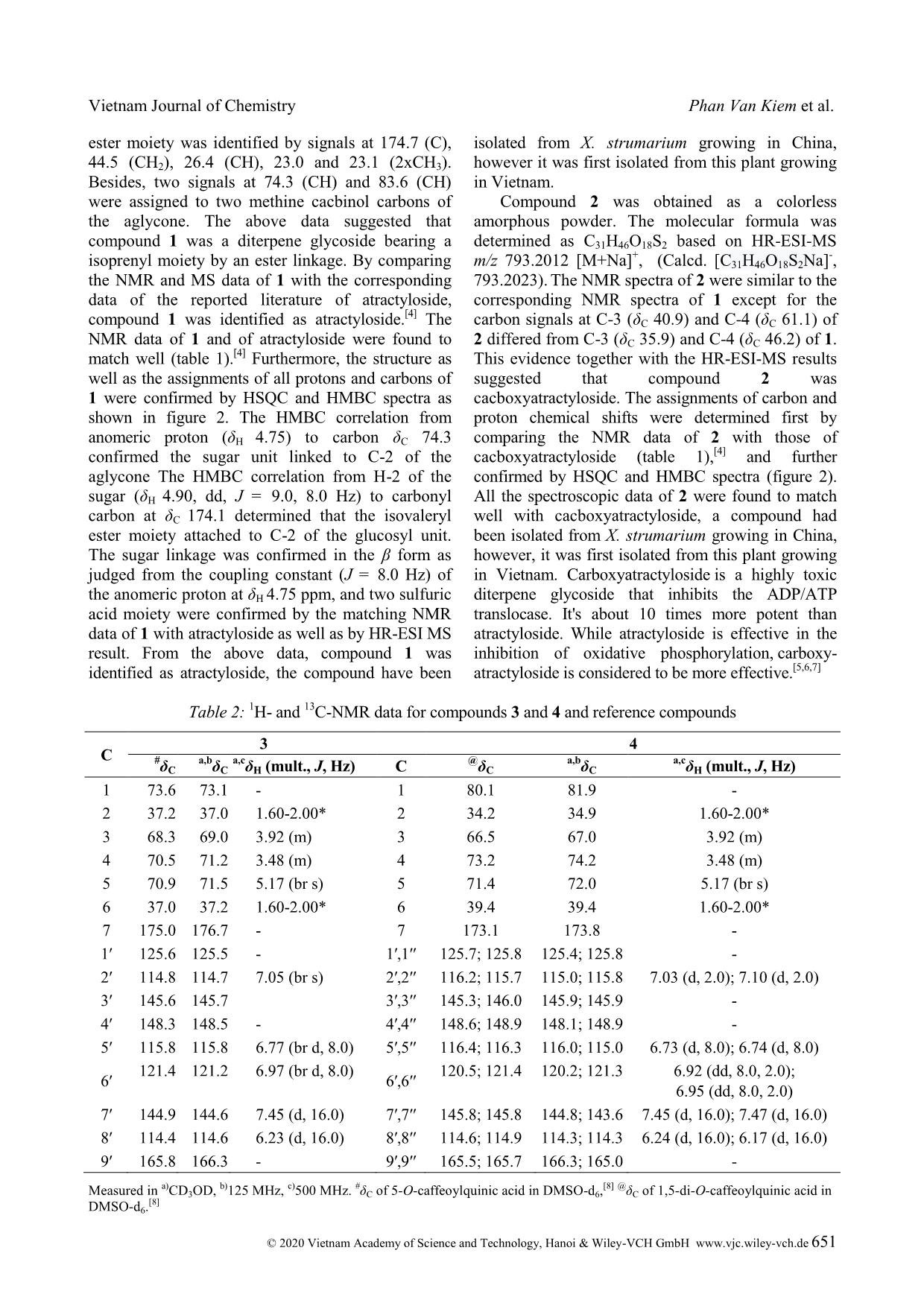
Trang 4
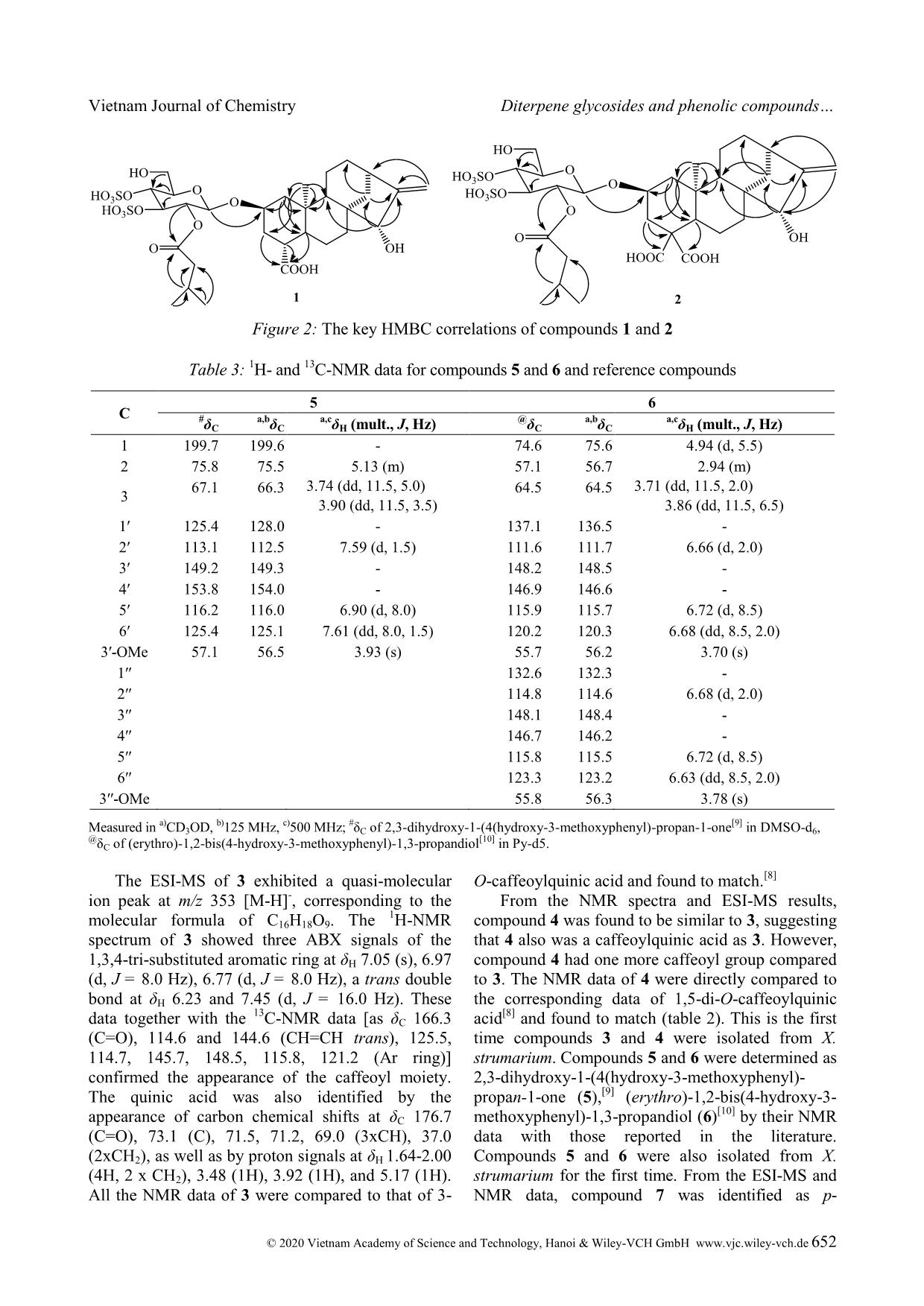
Trang 5
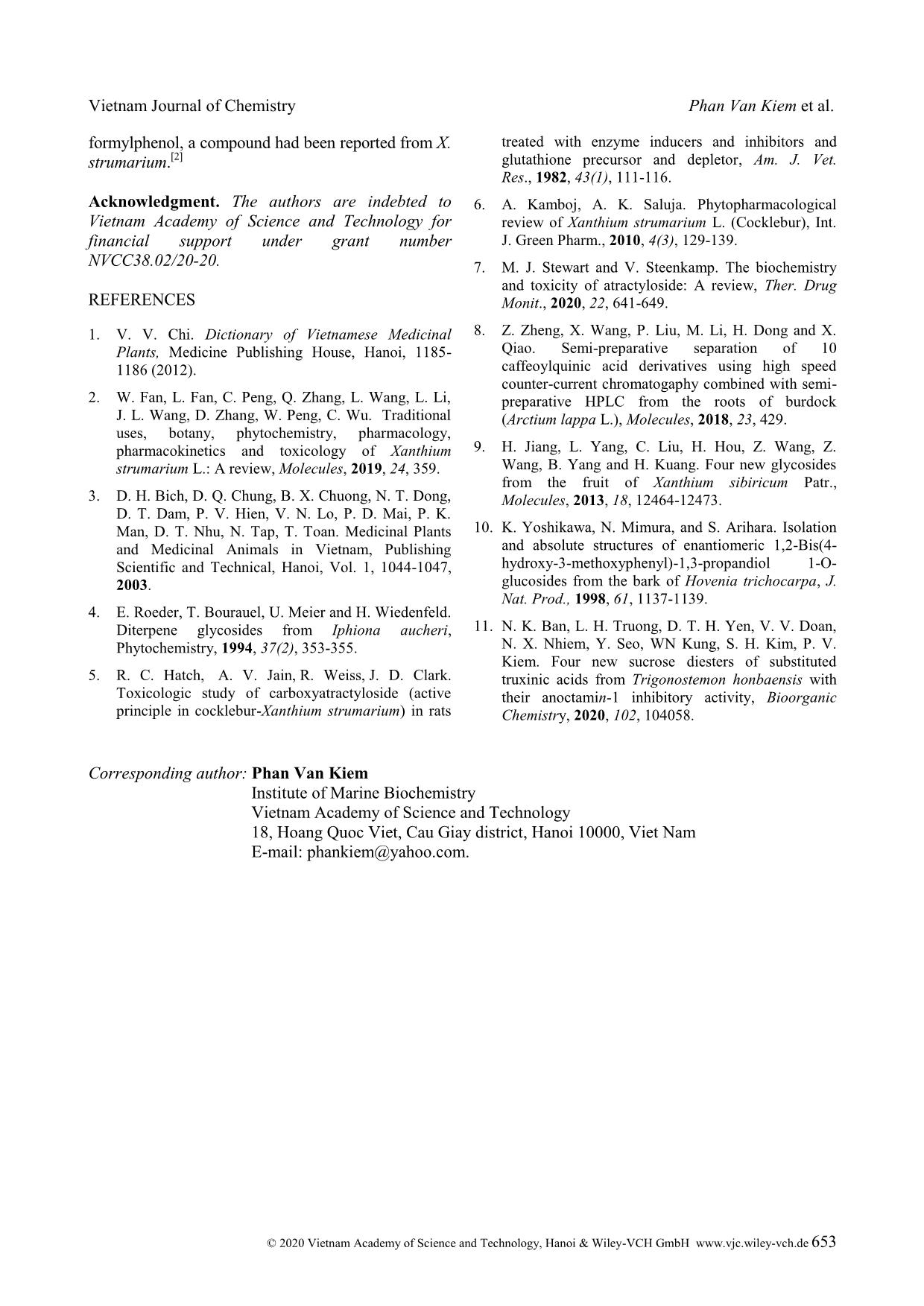
Trang 6
Tóm tắt nội dung tài liệu: Diterpene glycosides and phenolic compounds from the fruits of Xanthium strumarium
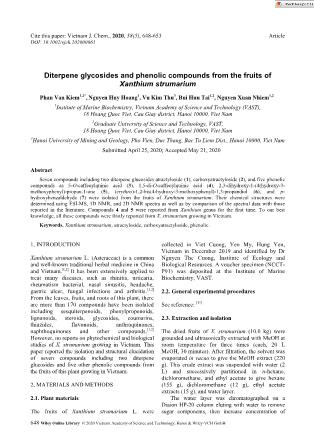
Cite this paper: Vietnam J. Chem., 2020, 58(5), 648-653 Article DOI: 10.1002/vjch.202000061 648 Wiley Online Library © 2020 Vietnam Academy of Science and Technology, Hanoi & Wiley-VCH GmbH Diterpene glycosides and phenolic compounds from the fruits of Xanthium strumarium Phan Van Kiem 1,2* , Nguyen Huy Hoang 1 , Vu Kim Thu 3 , Bui Huu Tai 1,2 , Nguyen Xuan Nhiem 1,2 1 Institute of Marine Biochemistry, Vietnam Academy of Science and Technology (VAST), 18 Hoang Quoc Viet, Cau Giay district, Hanoi 10000, Viet Nam 2 Graduate University of Science and Technology, VAST, 18 Hoang Quoc Viet, Cau Giay district, Hanoi 10000, Viet Nam 3 Hanoi University of Mining and Geology, Pho Vien, Duc Thang, Bac Tu Liem Dist., Hanoi 10000, Viet Nam Submitted April 25, 2020; Accepted May 21, 2020 Abstract Seven compounds including two diterpene glucosides atractyloside (1), carboxyatractyloside (2), and five phenolic compounds as 5-O-caffeoylquinic acid (3), 1,5-di-O-caffeoylquinic acid (4), 2,3-dihydroxy-1-(4(hydroxy-3- methoxyphenyl)-propan-1-one (5), (erythro)-1,2-bis(4-hydroxy-3-methoxyphenyl)-1,3-propandiol (6), and p- hydroxybenzaldehyde (7) were isolated from the fruits of Xanthium strumarium. Their chemical structures were determined using ESI-MS, 1D NMR, and 2D NMR spectra as well as by comparison of the spectral data with those reported in the literature. Compounds 4 and 5 were reported from Xanthium genus for the first time. To our best knowledge, all these compounds were firstly reported from X. strumarium growing in Vietnam. Keywords. Xanthium strumarium, atractyloside, carboxyatractyloside, phenolic. 1. INTRODUCTION Xanthium strumarium L. (Asteraceae) is a common and well-known traditional herbal medicine in China and Vietnam. [1,2] It has been extensively applied to treat many diseases, such as rhinitis, urticaria, rheumatism bacterial, nasal sinusitis, headache, gastric ulcer, fungal infections and arthritis. [1,2] From the leaves, fruits, and roots of this plant, there are more than 170 compounds have been isolated including sesquiterpenoids, phenylpropenoids, lignanoids, steroids, glycosides, coumarins, thiazides, flavonoids, anthraquinones, naphthoquinones and other compounds. [1,2] However, no reports on phytochemical and biological studies of X. strumarium growing in Vietnam. This paper reported the isolation and structural elucidation of seven compounds including two diterpene glucosides and five other phenolic compounds from the fruits of this plant growing in Vietnam. 2. MATERIALS AND METHODS 2.1. Plant materials The fruits of Xanthium strumarium L. were collected in Viet Cuong, Yen My, Hung Yen, Vietnam in December 2019 and identified by Dr Nguyen The Cuong, Institute of Ecology and Biological Resources. A voucher specimen (NCCT- P91) was deposited at the Institute of Marine Biochemistry, VAST. 2.2. General experimental procedures See reference: [11] 2.3. Extraction and isolation The dried fruits of X. strumarium (10.0 kg) were grounded and ultrasonically extracted with MeOH at room temperature for three times (each, 20 L MeOH, 30 minutes). After filtration, the solvent was evaporated in vacuo to give the MeOH extract (220 g). This crude extract was suspended with water (2 L) and successively partitioned in n-hexane, dichloromethane, and ethyl acetate to give hexane (155 g), dichloromethane (12 g), ethyl acetate extracts (15 g), and water layer. The water layer was chromatographed on a Diaion HP-20 column eluting with water to remove sugar components, then increase concentration of Vietnam Journal of Chemistry Phan Van Kiem et al. © 2020 Vietnam Academy of Science and Technology, Hanoi & Wiley-VCH GmbH www.vjc.wiley-vch.de 649 methanol in water (25, 50, 75 and 100 %, v/v) to obtain four fractions, KN1-KN4, respectively. The KN3 fraction was separated on a silica gel column chromatography, eluting with dichloromethane/ methanol (20/1, 10/1, 5/1, 1/1, v/v) to give four sub- fractions KN3A-KN3D, respectively. The KN3B (2.5 g) was chromatographed on a RP-18 column eluting with acetone/water (1/2, v/v) to give four smaller fractions, KN3B1-KN3B4. The KN3B1 was chromatographed on a silica gel column eluting with dichloromethane/acetone/water (1/4/0.5, v/v/v) as solvent to give four fractions, K3A-K3D. The K3A was purified on HPLC column (J’sphere ODS H-80, 250 mm×20 mm column) eluting with 40 % acetonitrile to yield 1 (11.0 mg). The K3D was purified on HPLC column (J’sphere ODS H-80, 250 mm×20 mm column) eluting with 45 % acetonitrile to yield 2 (9.0 mg). Compounds 3 (8.5 mg) and 4 (7.6 mg) from KN3B2 fraction by purifying on HPLC using J’sphere ODS H-80, 250 mm×20 mm column, ACN in H2O (32 %). The KN3B3 (3.1 g) fraction was chromatographed on a silica gel column eluting with dichloromethane/methanol (20/1, 10/1, 5/1, v/v) to give compounds 5 (8.4 mg), 6 (9.1 mg), and 7 (4.5 mg). Figure 1: Chemical structures of compounds 1-7 Atractyloside (1): Colorless amorphous powder; [ ] -54 o (c 0.1, MeOH); mp. 205-206 o C; ESI-MS m/z 725.2129 [M-H] - , (Calcd. [C30H45O16S2] - , 725.2149); 1 H-NMR (CD3OD, 500 MHz) and 13 C- NMR (CD3OD, 125 MHz) data, see table 1. Carboxyatractyloside (2): Colorless amorphous powder; [ ] -45.0 (c 0.1, MeOH); mp. 273-275 o C. HR-ESI-MS m/z 793.2012 [M+Na] + , (Calcd. [C31H46O18S2Na] - , 793.2023); 1 H-NMR (CD3OD, 500 MHz) and 13 C-NMR (CD3OD, 125 MHz) data, see table 1. 5-O-caffeoylquinic acid (neochlorogenic acid) (3): Colorless amorphous; [ ] +52 (c 0.1, MeOH); ESI-MS m/z 353 [M-H] - ; C16H18O9. 1 H-NMR (CD3OD, 500 MHz) and 13 C-NMR (CD3OD, 125 MHz) data, see table 2. 1,5-di-O-caffeoylquinic acid (4): Colorless amorphous; [ ] +34.0 (c 0.1, MeOH); ESI-MS m/z 515 [M-H] - ; C25H24O12; 1 H-NMR ... 9 [M-H] - ; C17H20O6. 1 H-NMR (CD3OD, 500 MHz) and 13 C-NMR (CD3OD, 125 MHz) data, see table 3. p-Hydroxybenzaldehyde (7): Light yellow powder; Mp 112-116 o C. ESI-MS m/z 123 [M+H] + . 1 H-NMR (500 MHz, DMSO-d6) δ (ppm): 7.68 (2H, d, J = 8.5 Hz, H-2, H-6), 6.83 (2H, d, J = 8.5 Hz, H- 3, H-5), 9.71 (1H, s, H-7). 13 C-NMR (125 MHz, DMSO-d6) δ (ppm): 126.8 (C-1), 132.1 (C-2, C-6), 116.4 (C-3, C-5), 166.0 (C-4), 190.2 (C-7). Vietnam Journal of Chemistry Diterpene glycosides and phenolic compounds © 2020 Vietnam Academy of Science and Technology, Hanoi & Wiley-VCH GmbH www.vjc.wiley-vch.de 650 3. RESULTS AND DISCUSSION Compound 1 was obtained as a colorless amorphous powder. The molecular formula was determined as C30H16O16S2 based on HR-ESI-MS m/z 725.2129 [(Calcd. [C30H45O16S2] - , 725.2149). The 1 H-NMR spectrum of 1 (in CD3OD) showed one methyl singlet at δH 1.04, two other singlets of the =CH2 protons at δH 5.20 and 5.09, two methine cacbinol protons at δH 3.78 (br s) and 4.30 (m). Table 1: 1 H- and 13 C-NMR data for compounds 1 and 2 and reference compounds C 1 2 #δC a,bδC a,cδH (mult., J in Hz) @δC a,bδC a,cδH (mult., J in Hz) 1 47.9 48.5 0.77 (dd, 11.5, 11.5) 2.32 (dd, 11.5, 2.0) 49.3 48.5 0.83 (dd, 11.5, 11.5) 2.29 (dd, 11.5, 2.0) 2 72.6 74.3 4.30 (m) 76.6 74.6 4.39 (m) 3 35.2 35.9 1.20 (m)/2.45 (dd, 10.0, 2.0) 42.4 40.9 1.50*/2.56 (dd, 10.0, 3.0) 4 45.6 46.2 2.64 (t, 4.0) 63.2 61.1 - 5 49.4 50.5 1.44 (m) 54.1 53.2 1.73 (m) 6 25.8 26.6 1.67 (m)/1.95 (m) 25.7 23.9 1.77 (m)/1.84 (m) 7 35.9 36.2 1.46 (m)/1.70 (m) 37.6 36.2 1.44 (m)/1.63 (m) 8 47.2 48.5 - 50.2 48.7 - 9 52.7 54.7 1.06 (d, 7.5) 55.6 55.1 1.10 (d, 7.5) 10 40.2 41.8 - 42.8 41.7 - 11 17.9 19.2 1.50 (m)/1.65 (m) 20.9 19.3 1.50 (m)/1.65 (m) 12 32.3 33.6 1.50 (m)/1.64 (m) 35.0 33.7 1.50 (m)/1.64 (m) 13 41.8 43.7 2.72 (br s) 44.8 43.7 2.71 (br s) 14 36.0 37.2 1.40 (dd, 11.0, 5.0) 1.91 (d, 11.0) 38.8 38.8 1.39 (dd, 11.5, 4.5) 1.92 (d, 11.5) 15 81.3 83.6 3.78 (br s) 85.0 83.5 - 16 159.5 160.4 - 161.5 160.4 - 17 107.4 109.0 5.20 (s)/5.09 (s) 111.7 108.9 5.19 (s)/5.08 (s) 18 181.3 179.1 - 19 178.4 179.5 - 180.6 179.1 - 20 16.9 17.3 1.04 (s) 19.9 17.9 1.05 (s) 1 98.1 100.5 4.75 (d, 8.0) 100.9 100.7 4.74 (d, 8.0) 2 71.9 73..4 4.90 (dd, 9.0, 8.0) 74.6 72.6 4.80 (dd, 9.0, 8.0) 3 77.7 80.3 4.59 (t, 9.0) 81.8 82.9 4.42 (t, 9.0) 4 73.6 75.3 4.35 (t, 9.0) 77.0 70.9 3.65 (t, 9.0) 5 75.3 76.3 3.53 (m) 76.9 77.3 3.42 (m) 6 61.1 62.4 3.90 (br s) 63.2 62.3 3.74 (dd, 11.5, 4.0) 3.88 (br d, 11.5) 1 170.7 174.7 - 177.7 173.9 - 2 43.0 44.5 2.30 (d, 7.0) 46.0 44.4 2.28 (d, 7.0) 3 24.7 26.4 2.10 (m) 28.1 26.5 2.13 (m) 4 22.5 23.1 0.99 (d, 6.5) 24.9 23.0 0.99 (d, 6.5) 5 22.5 23.0 0.98 (d, 6.5) 24.8 22.9 0.98 (d, 6.5) Measured in a)CD3OD, b)125 MHz, c)500 MHz. #δC of atractyloside in DMSO-d6, [4] @δC of carboxyatractyloside in D2O [4] *Overlapped signals. In addition, one glucosyl unit was identified by the exhibition of an anomeric proton at δH 4.75 (J = 7.5 Hz), two oxygenated methylene protons at δH 3.90 (2H), and the isovaleryl moiety was identified by two doublet methyl groups at δH 0.98 and 0.99 (J = 6.5 Hz), and two methylene protons at δH 2.30 (d, J = 7.0 Hz). The 13 C-NMR spectrum of 1 exhibited 30 carbon signals including two carbonyl groups at δC 179.5 and 174.7, the >C=CH2 group at δC 160.4 (C) and 109.0 (CH2), one glucosyl unit was identified by the signals at 100.5, 73.4, 80.3, 75.3, 76.3 (5 x CH) and 62.4 (CH2), and the isovaleryl Vietnam Journal of Chemistry Phan Van Kiem et al. © 2020 Vietnam Academy of Science and Technology, Hanoi & Wiley-VCH GmbH www.vjc.wiley-vch.de 651 ester moiety was identified by signals at 174.7 (C), 44.5 (CH2), 26.4 (CH), 23.0 and 23.1 (2xCH3). Besides, two signals at 74.3 (CH) and 83.6 (CH) were assigned to two methine cacbinol carbons of the aglycone. The above data suggested that compound 1 was a diterpene glycoside bearing a isoprenyl moiety by an ester linkage. By comparing the NMR and MS data of 1 with the corresponding data of the reported literature of atractyloside, compound 1 was identified as atractyloside. [4] The NMR data of 1 and of atractyloside were found to match well (table 1). [4] Furthermore, the structure as well as the assignments of all protons and carbons of 1 were confirmed by HSQC and HMBC spectra as shown in figure 2. The HMBC correlation from anomeric proton (δH 4.75) to carbon δC 74.3 confirmed the sugar unit linked to C-2 of the aglycone The HMBC correlation from H-2 of the sugar (δH 4.90, dd, J = 9.0, 8.0 Hz) to carbonyl carbon at δC 174.1 determined that the isovaleryl ester moiety attached to C-2 of the glucosyl unit. The sugar linkage was confirmed in the β form as judged from the coupling constant (J = 8.0 Hz) of the anomeric proton at δH 4.75 ppm, and two sulfuric acid moiety were confirmed by the matching NMR data of 1 with atractyloside as well as by HR-ESI MS result. From the above data, compound 1 was identified as atractyloside, the compound have been isolated from X. strumarium growing in China, however it was first isolated from this plant growing in Vietnam. Compound 2 was obtained as a colorless amorphous powder. The molecular formula was determined as C31H46O18S2 based on HR-ESI-MS m/z 793.2012 [M+Na] + , (Calcd. [C31H46O18S2Na] - , 793.2023). The NMR spectra of 2 were similar to the corresponding NMR spectra of 1 except for the carbon signals at C-3 (δC 40.9) and C-4 (δC 61.1) of 2 differed from C-3 (δC 35.9) and C-4 (δC 46.2) of 1. This evidence together with the HR-ESI-MS results suggested that compound 2 was cacboxyatractyloside. The assignments of carbon and proton chemical shifts were determined first by comparing the NMR data of 2 with those of cacboxyatractyloside (table 1), [4] and further confirmed by HSQC and HMBC spectra (figure 2). All the spectroscopic data of 2 were found to match well with cacboxyatractyloside, a compound had been isolated from X. strumarium growing in China, however, it was first isolated from this plant growing in Vietnam. Carboxyatractyloside is a highly toxic diterpene glycoside that inhibits the ADP/ATP translocase. It's about 10 times more potent than atractyloside. While atractyloside is effective in the inhibition of oxidative phosphorylation, carboxy- atractyloside is considered to be more effective. [5,6,7] Table 2: 1 H- and 13 C-NMR data for compounds 3 and 4 and reference compounds C 3 4 # δC a,b δC a,c δH (mult., J, Hz) C @ δC a,b δC a,c δH (mult., J, Hz) 1 73.6 73.1 - 1 80.1 81.9 - 2 37.2 37.0 1.60-2.00* 2 34.2 34.9 1.60-2.00* 3 68.3 69.0 3.92 (m) 3 66.5 67.0 3.92 (m) 4 70.5 71.2 3.48 (m) 4 73.2 74.2 3.48 (m) 5 70.9 71.5 5.17 (br s) 5 71.4 72.0 5.17 (br s) 6 37.0 37.2 1.60-2.00* 6 39.4 39.4 1.60-2.00* 7 175.0 176.7 - 7 173.1 173.8 - 1′ 125.6 125.5 - 1′,1′′ 125.7; 125.8 125.4; 125.8 - 2′ 114.8 114.7 7.05 (br s) 2′,2′′ 116.2; 115.7 115.0; 115.8 7.03 (d, 2.0); 7.10 (d, 2.0) 3′ 145.6 145.7 3′,3′′ 145.3; 146.0 145.9; 145.9 - 4′ 148.3 148.5 - 4′,4′′ 148.6; 148.9 148.1; 148.9 - 5′ 115.8 115.8 6.77 (br d, 8.0) 5′,5′′ 116.4; 116.3 116.0; 115.0 6.73 (d, 8.0); 6.74 (d, 8.0) 6′ 121.4 121.2 6.97 (br d, 8.0) 6′,6′′ 120.5; 121.4 120.2; 121.3 6.92 (dd, 8.0, 2.0); 6.95 (dd, 8.0, 2.0) 7′ 144.9 144.6 7.45 (d, 16.0) 7′,7′′ 145.8; 145.8 144.8; 143.6 7.45 (d, 16.0); 7.47 (d, 16.0) 8′ 114.4 114.6 6.23 (d, 16.0) 8′,8′′ 114.6; 114.9 114.3; 114.3 6.24 (d, 16.0); 6.17 (d, 16.0) 9′ 165.8 166.3 - 9′,9′′ 165.5; 165.7 166.3; 165.0 - Measured in a)CD3OD, b)125 MHz, c)500 MHz. #δC of 5-O-caffeoylquinic acid in DMSO-d6, [8] @δC of 1,5-di-O-caffeoylquinic acid in DMSO-d6. [8] Vietnam Journal of Chemistry Diterpene glycosides and phenolic compounds © 2020 Vietnam Academy of Science and Technology, Hanoi & Wiley-VCH GmbH www.vjc.wiley-vch.de 652 Figure 2: The key HMBC correlations of compounds 1 and 2 Table 3: 1 H- and 13 C-NMR data for compounds 5 and 6 and reference compounds C 5 6 #δC a,bδC a,cδH (mult., J, Hz) @δC a,bδC a,cδH (mult., J, Hz) 1 199.7 199.6 - 74.6 75.6 4.94 (d, 5.5) 2 75.8 75.5 5.13 (m) 57.1 56.7 2.94 (m) 3 67.1 66.3 3.74 (dd, 11.5, 5.0) 3.90 (dd, 11.5, 3.5) 64.5 64.5 3.71 (dd, 11.5, 2.0) 3.86 (dd, 11.5, 6.5) 1′ 125.4 128.0 - 137.1 136.5 - 2′ 113.1 112.5 7.59 (d, 1.5) 111.6 111.7 6.66 (d, 2.0) 3′ 149.2 149.3 - 148.2 148.5 - 4′ 153.8 154.0 - 146.9 146.6 - 5′ 116.2 116.0 6.90 (d, 8.0) 115.9 115.7 6.72 (d, 8.5) 6′ 125.4 125.1 7.61 (dd, 8.0, 1.5) 120.2 120.3 6.68 (dd, 8.5, 2.0) 3′-OMe 57.1 56.5 3.93 (s) 55.7 56.2 3.70 (s) 1′′ 132.6 132.3 - 2′′ 114.8 114.6 6.68 (d, 2.0) 3′′ 148.1 148.4 - 4′′ 146.7 146.2 - 5′′ 115.8 115.5 6.72 (d, 8.5) 6′′ 123.3 123.2 6.63 (dd, 8.5, 2.0) 3′′-OMe 55.8 56.3 3.78 (s) Measured in a)CD3OD, b)125 MHz, c)500 MHz; #δC of 2,3-dihydroxy-1-(4(hydroxy-3-methoxyphenyl)-propan-1-one [9] in DMSO-d6, @δC of (erythro)-1,2-bis(4-hydroxy-3-methoxyphenyl)-1,3-propandiol [10] in Py-d5. The ESI-MS of 3 exhibited a quasi-molecular ion peak at m/z 353 [M-H] - , corresponding to the molecular formula of C16H18O9. The 1 H-NMR spectrum of 3 showed three ABX signals of the 1,3,4-tri-substituted aromatic ring at δH 7.05 (s), 6.97 (d, J = 8.0 Hz), 6.77 (d, J = 8.0 Hz), a trans double bond at δH 6.23 and 7.45 (d, J = 16.0 Hz). These data together with the 13 C-NMR data [as δC 166.3 (C=O), 114.6 and 144.6 (CH=CH trans), 125.5, 114.7, 145.7, 148.5, 115.8, 121.2 (Ar ring)] confirmed the appearance of the caffeoyl moiety. The quinic acid was also identified by the appearance of carbon chemical shifts at δC 176.7 (C=O), 73.1 (C), 71.5, 71.2, 69.0 (3xCH), 37.0 (2xCH2), as well as by proton signals at δH 1.64-2.00 (4H, 2 x CH2), 3.48 (1H), 3.92 (1H), and 5.17 (1H). All the NMR data of 3 were compared to that of 3- O-caffeoylquinic acid and found to match. [8] From the NMR spectra and ESI-MS results, compound 4 was found to be similar to 3, suggesting that 4 also was a caffeoylquinic acid as 3. However, compound 4 had one more caffeoyl group compared to 3. The NMR data of 4 were directly compared to the corresponding data of 1,5-di-O-caffeoylquinic acid [8] and found to match (table 2). This is the first time compounds 3 and 4 were isolated from X. strumarium. Compounds 5 and 6 were determined as 2,3-dihydroxy-1-(4(hydroxy-3-methoxyphenyl)- propan-1-one (5), [9] (erythro)-1,2-bis(4-hydroxy-3- methoxyphenyl)-1,3-propandiol (6) [10] by their NMR data with those reported in the literature. Compounds 5 and 6 were also isolated from X. strumarium for the first time. From the ESI-MS and NMR data, compound 7 was identified as p- Vietnam Journal of Chemistry Phan Van Kiem et al. © 2020 Vietnam Academy of Science and Technology, Hanoi & Wiley-VCH GmbH www.vjc.wiley-vch.de 653 formylphenol, a compound had been reported from X. strumarium. [2] Acknowledgment. The authors are indebted to Vietnam Academy of Science and Technology for financial support under grant number NVCC38.02/20-20. REFERENCES 1. V. V. Chi. Dictionary of Vietnamese Medicinal Plants, Medicine Publishing House, Hanoi, 1185- 1186 (2012). 2. W. Fan, L. Fan, C. Peng, Q. Zhang, L. Wang, L. Li, J. L. Wang, D. Zhang, W. Peng, C. Wu. Traditional uses, botany, phytochemistry, pharmacology, pharmacokinetics and toxicology of Xanthium strumarium L.: A review, Molecules, 2019, 24, 359. 3. D. H. Bich, D. Q. Chung, B. X. Chuong, N. T. Dong, D. T. Dam, P. V. Hien, V. N. Lo, P. D. Mai, P. K. Man, D. T. Nhu, N. Tap, T. Toan. Medicinal Plants and Medicinal Animals in Vietnam, Publishing Scientific and Technical, Hanoi, Vol. 1, 1044-1047, 2003. 4. E. Roeder, T. Bourauel, U. Meier and H. Wiedenfeld. Diterpene glycosides from Iphiona aucheri, Phytochemistry, 1994, 37(2), 353-355. 5. R. C. Hatch, A. V. Jain, R. Weiss, J. D. Clark. Toxicologic study of carboxyatractyloside (active principle in cocklebur-Xanthium strumarium) in rats treated with enzyme inducers and inhibitors and glutathione precursor and depletor, Am. J. Vet. Res., 1982, 43(1), 111-116. 6. A. Kamboj, A. K. Saluja. Phytopharmacological review of Xanthium strumarium L. (Cocklebur), Int. J. Green Pharm., 2010, 4(3), 129-139. 7. M. J. Stewart and V. Steenkamp. The biochemistry and toxicity of atractyloside: A review, Ther. Drug Monit., 2020, 22, 641-649. 8. Z. Zheng, X. Wang, P. Liu, M. Li, H. Dong and X. Qiao. Semi-preparative separation of 10 caffeoylquinic acid derivatives using high speed counter-current chromatogaphy combined with semi- preparative HPLC from the roots of burdock (Arctium lappa L.), Molecules, 2018, 23, 429. 9. H. Jiang, L. Yang, C. Liu, H. Hou, Z. Wang, Z. Wang, B. Yang and H. Kuang. Four new glycosides from the fruit of Xanthium sibiricum Patr., Molecules, 2013, 18, 12464-12473. 10. K. Yoshikawa, N. Mimura, and S. Arihara. Isolation and absolute structures of enantiomeric 1,2-Bis(4- hydroxy-3-methoxyphenyl)-1,3-propandiol 1-O- glucosides from the bark of Hovenia trichocarpa, J. Nat. Prod., 1998, 61, 1137-1139. 11. N. K. Ban, L. H. Truong, D. T. H. Yen, V. V. Doan, N. X. Nhiem, Y. Seo, WN Kung, S. H. Kim, P. V. Kiem. Four new sucrose diesters of substituted truxinic acids from Trigonostemon honbaensis with their anoctamin-1 inhibitory activity, Bioorganic Chemistry, 2020, 102, 104058. Corresponding author: Phan Van Kiem Institute of Marine Biochemistry Vietnam Academy of Science and Technology 18, Hoang Quoc Viet, Cau Giay district, Hanoi 10000, Viet Nam E-mail: phankiem@yahoo.com.
File đính kèm:
 diterpene_glycosides_and_phenolic_compounds_from_the_fruits.pdf
diterpene_glycosides_and_phenolic_compounds_from_the_fruits.pdf

